
Murchison Falls
Murchison Falls National Park:A snapshot
If you are in Uganda for any length of time, a trip to the d Murchison National Park for a safari and to see the Murchison Falls is a must. Located in North western Uganda, Murchison National Park is Uganda’s largest conservation area with host of large game and bird species. The park is the most popular Safari destination for the tourists and nationals alike. One of the main reasons being that it is only 5 hours away from Kampala. Queen Elisabeth National Park, another great safari destination, is much farther and requires more than a couple of day’s commitment to explore the Park.
A cursory glance at the information material on the Park shows, that the Park has hosted many famous people dating back to the early 1900s; Winston Churchill visited Murchison Falls in 1907, Edward the V11 in 1930s, Ernest Hemingway in 1954, and the Queen mother in 1959, just to mention a few.
The Murchison falls has also been the background for many movies shot in the 1950s; the African Queen, starring Katherine Hepburn and Humphrey Bogart, being one of them.
In the time that I have been in Uganda, I have visited the National Park twice. Each time it has been an amazing experience.
Booking the trip: Paara ‘the place of hippos’
My first trip, last October, with my nephew Rayan, was a complete adventure.
I was new in Uganda, had never been farther than Jinja and had absolutely no idea what to expect. Rayan was also visiting Africa for the first time and had never been on a Safari. Our twenty-six year old driver, Rogers (the protagonist in this account), had been up to Masindi, many years ago with his school, but not beyond Masindi to the National Park.
This meant our planning had to be impeccable. We were told that the 5 hour-long journey was not without its perils. The road through the National Park was pretty treacherous and cars had to be in top condition to avoid any mishaps.
Booking the safari itself was fairly easy. A trip to the Marasa Safari Company in the industrial area (complete address below) resolved all accommodation issues. The staff at Marasa is fairly knowledgeable and helpful. The Park has many lodges managed by Marasa and we were given several options.
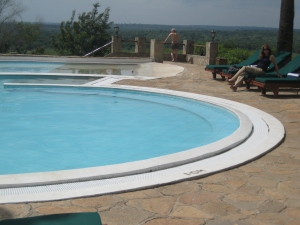
Paara Poolside…
We decided to book Para lodge, known as the jewel of the Nile and considered the best option both for the game and boat safari. It is also known to have the largest concentration of wild life in the Park. In the local language Para means ‘the place of hippos’(True to its name, we would later find hordes and hordes of hippos, submerged in the Nile Victoria, around Paara).
As soon as we booked with Marasa, we were given a comprehensive information pack; Map with a timeline, accommodation details, safari timings, etc.
Preparations: Rogers’ mad obsession
Booking done, the week before the trip, Rayan and I got busy with shopping for food supplies, packing the right clothes, books, cards etc. and gathering more information on Para and its surroundings; the more we read the more excited we got. Rogers on the other hand, for some odd reason, was obsessed with getting the right music for the car journey. Both Rayan and I were taking our own IPods but did not have the heart to tell Rogers. We played along with his mad search for appropriate music and even gave him a list of our favorite songs (needless to say the music later played in our car was only Rogers list).
In hindsight, there was something ominous about Rogers’ whole music obsession and general state of excitement.
The Journey to Paara: Disaster in the National Park
Map in hand, we set off really early in the morning to avoid the traffic jam. Our aim was to get to Masindi in three hours (as suggested by the map) and then cross the national park in another two hours; in time for the ferry crossing through the Nile to Para Lodge.
At the lodge our boat safari was booked for 2.30 in the afternoon. So if we could cross at 1 O’clock, we would have enough time for a leisurely lunch, before setting off on a 3 hour river safari.
Rogers, working on his own timeline, and keen to beat the 3 hour record set on the Map, stepped on the accelerator, despite my constant appeals to the contrary. Passing through Luwero, we turned off the Gullu road, just beyond the Kafu Bridge and reached Masindi, well before time. Roger was euphoric.
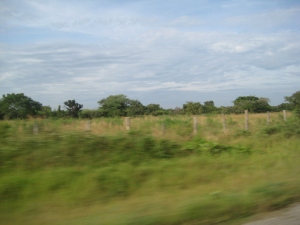
on our way to Paara near Masindi
After Macindi, we turned on to a dirt road towards the National Park gate. The Map showed we still had another 85 kms to cover through the National Park to reach Paara. At the Park entrance we were told that the speed limit is 40km per hour and it would take us around 2 hours to get to the ferry crossing and to Paara.
The beauty of the park, the weather, the wild life, the fauna, is difficult to describe. We passed through thick green forest to ever-changing undulating landscape; wild grass, flowering shrubs, giant ant hills, families of chimpanzees –and of course the glorious skies. The conversation in the car, mostly between Rayan and I, was getting more and more fantastic; the impossible seemed possible – ‘destiny, fate, divinity….all had conspired to put us on this road’…a life lesson was being taught…everything made sense…..and inside the little black RAV4, life was perfect…… soon we were exhausted by our endless (one hour) elation. In the background, Rogers continued to blare nineties top hits and swerving the car around frighteningly huge fissures and splits in the park road.
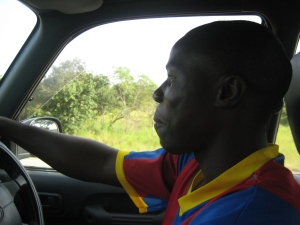
Rogers; minutes away from disaster…
Rogers was on a high of his own…..my constant reprimand to slow down was met with great cheer and ignored the very next second. We continued to drive in this state of euphoria with not a car in sight; Rogers humming and lip singing along old hits and Rayan and I chatting – suddenly we found our car hurtling down the narrow road, inches away from a huge split in the road, Rogers had stopped singing, the car was heading for a deep trench along the road; In that split second I thought of injuries, emergency numbers, nearest hospital….and of course ….Paara……and then the inevitable crash….the impact was on Rogers side…I instinctively knew that Rayan and I were fine; I went through a sick fear for Rogers…but the next minute when I saw him emerging from the car unhurt ..… I knew I wanted to kill him….
The trip was ruined, the car was stuck, we were miles away from civilization, and the ferry was leaving in half an hour….I found myself laughing and threatening to kill Rogers in the same breath…..Rogers was clearly traumatized and fully aware of the gravity of the situation…
Ironically, we were also in the most beautiful part of the National Park…..
I could not forgive Rogers…….. …suddenly he started circling the car and repeating, over and over again, ‘Sheeba, I will get us out of here’…..he managed to open the car door and get back into the car…he started reversing but the car remained in the trench….with only two right side wheels engaging with the ground it seemed like an impossible task…. I heard the car doors scratching against the trench walls and I wanted to cry.
Rayan was equally distressed but tried hard to remain calm and kept urging and guiding Rogers….suddenly we found Rogers backing onto a rock jutting out of the trench…..and a few tries later the car was out of the trench…
This was indeed a miracle, but the three of us were too traumatized to be happy. We quickly jumped into the car to get to the ferry crossing in time. I was still angry with Rogers and decided to drive the car myself for the remaining part of the journey.
Back in the car, it took us sometime to notice that our car was full of tsetse flies (pronounced sesse). These are larger than horse flies and feed entirely on blood and are a serious health risk, causing what is commonly known as sleeping sickness.
The flies started attaching Rayan and Rogers. Rogers with his nerves already frayed by the crash started fighting back by slapping various parts of his body to get rid of the flies (which was a hilarious sight)……the flies were too many to be fought siting in the car. We all stepped out again, found rags in the back of the car and started swatting the flies…the battle was won within five minutes and we resumed our journey to the ferry crossing.
Within half an hour, we reached the Nile Victoria with Paara visible in the distance and joined a long cue of cars waiting to cross over to Paara.
Paara: The Lunch : Making peace with Rogers
Paara was every bit as charming as described in the brochures. Constructed in the 1950s, it has maintained its old world charm. You can easily imagine Katherine Hepburn and Humphrey Bogart checking in at the reception desk with their elaborate luggage.
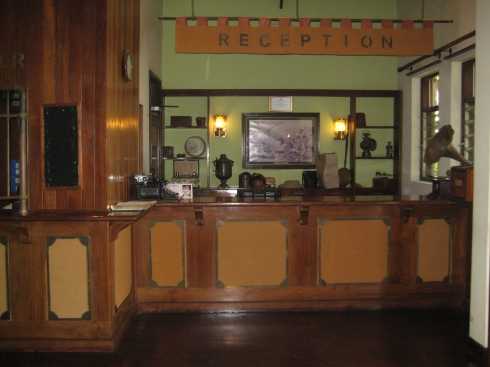
Paara reception desk..
We were advised to proceed quickly to the dining hall for lunch. The good thing with Paara is that although the drivers have separate accommodation, they have the same dining privileges and eat with all the other guests.
When we reached the dining hall we found a much recovered Rogers already seated and enjoying the elaborate buffet. My anger had dissipated as soon as we arrived in Paara…and in the dining hall, I made my peace with Rogers.
The Boat Safari: The death roll
The boat cruise is only a five minutes’ drive from Para. Rayan and I arrived to find all upper deck seats occupied. We settled ourselves downstairs. The boat took of right on time. The weather was perfect, the bar offered free water and a selection of other beverages for sale.
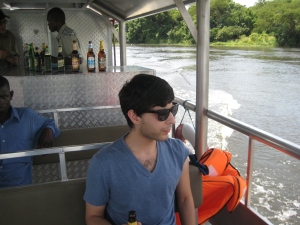
Rayan enjoying a drink…
As expected the Boat had an experienced guide on board. As the boat moved away from the shore into deeper waters, the guide gave us a brief history of Murchison falls and what to expect on the journey to the Falls.
We were told that we would see a lot of wild life; hippos, water buffalos, rare aquatic antelope, giant forest hog, Uganda kob, waterbuck and many rare species of birds. The water was full of crocodiles but since it was really hot, the guide felt the crocodiles may remain submerged in water and we may not be able to see them on this trip.
Within 5 minutes of the journey we found families of hippos basking in the afternoon sun. There was much excitement on the boat. People moved freely between the lower and upper deck to get the best possible view and take pictures. The boat got really close to the hippos, and we were able to take many good shots. Hippos were mostly submerged in water but as the boat got closer we found hordes and hordes of them emerging out of their resting places and moving to the shore. This was the best time to take a photograph as you got their full form and size. We were told that despite their cute image, hippos were the number one killers of humans in Uganda.
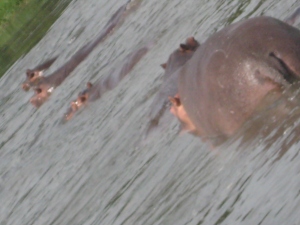
Hippos walking away from the boat
We also passed many water buffalos sitting alone along the Nile bank. The guide explained that the lone buffalo is usually an old male who has been kicked out of the herd as the female takes up with a younger male, more capable of leading the herd. The old buffalo, now herdless and alone, stays around the bank, half-submerged in water to protect himself from predators like the lions and the leopards. Locally he is refered to as the ‘Old Loser’ which Rayan and I thought was really cruel.
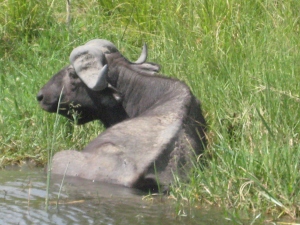
The old loser..
Having seen many hippos, water buffalos and rare birds, Rayan and I were really keen to see some crocodiles. Suddenly we heard a huge commotion on the upper deck and people pointing at some movement on the far right of the boat. Before we could figure out what all the excitement was about the guide announced that a dead hippo was floating on its back and over fifteen crocodiles were heading towards the Hippo. He further told us that the hippos and the crocodiles coexist quiet happily, its only when a hippo dies that the crocodiles will come to feast on it. This was more excitement than we expected. The scene was at once riveting and revolting.
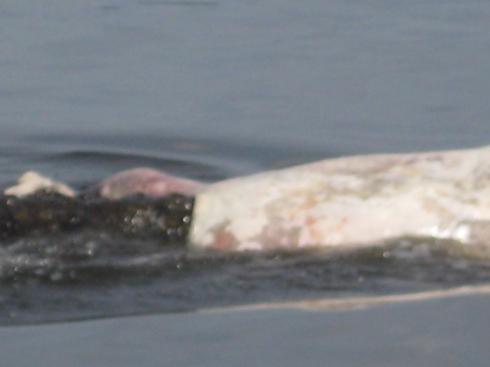
A crocodile ripping away at the hippo carcass
The carcass was soon attached by several crocodiles, emerging from nowhere. We ran from the lower deck to the upper deck to get a better view.
We saw a whole army of crocodiles heading towards the carcass and our boat moved slowly in the direction of the gruesome scene. We stopped only a few feet away from the scene, which was right out of the national geographic channel.
We got enough time to take all the pictures we wanted en route to the Falls. The water quality changed drastically as we moved closer to the Falls and the Nile surface got covered with foam. The boat stopped close to a collection of huge rocks jutting out from the water for us to take pictures. Turn by turn we were helped on to the rocks for photographs.
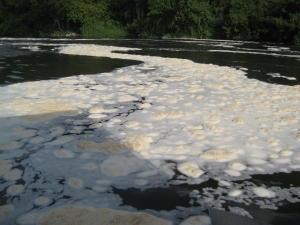
Nile surface covered with foam as we approach the falls
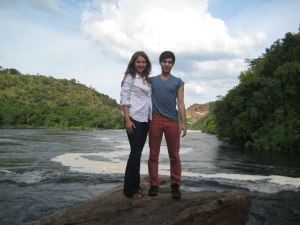
Me and Rayan; Photo opp during the water safari
Picture taken, the falls admired we headed back to Paara. It was getting cooler and we were beginning to get tired and hungry. We saw many animals on our way back but the atmosphere in the boat was more subdued. The professional photographers however remained focused on the ever changing scenery and would not miss a single flutter in the trees or ripple in the waters.
We came back to the shore to find the banks just below Paara busy with animal life. The cars parked to take guest back had monkeys happily parked on top of cars waiting to welcome the guests. We had an early dinner and sat out around the pool with a big group of French soldiers and watched a local group perform traditional singing and dancing. We retired early as we had scheduled a game safari the following day at dawn.
The Game Safari : Who is watching whom?
The game Safari turned out to be a completely different experience; We left in a long convoy from Paara, mostly the French soldiers we had met the night previous. The game safari was far more strenuous than the boat Safari, especially at six in the morning. We were amazed to find so many different animals and bird species in the n National Park. However, we realized that a seasoned guide is extremely important for tracking the big game and navigating through the Park.
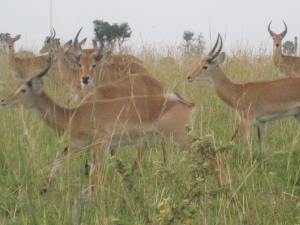
Uganda Kobs
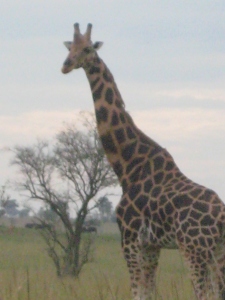
giraffes that love to stare
I found going through miles and miles of Savannah a completely novel experience and seeing animals running around freely a privilege. Nothing is more exhilarating than spotting big game like an elephant or a lion. Our guide was successful in tracking down herds of elephants but we failed to spot any lions or leopards, known to be more reticent.
However, the most fascinating part of the safari was the animals curiosity about humans; especially the Uganda Kobs and the Giraffes; posing and staring straight at the cameras and the silly people behind the cameras.
On our way back, both Rayan and I vowed to return to the National Park and stay at the Chobe lodge, a newly refurbished lodge a two-hour journey from Paara. The lodge is known for its amazing setting and a constant view of the hippos and other wild life.
Marasa Africa
Address, City, State, Country Plot 96-98, 5th Street Industrial Area, PO Box 22827, Kampala, Uganda
Kampala, Uganda
Office Phone 256 (0)31 2260260
Mobile Phone
Fax 256 (0)31 2260262



















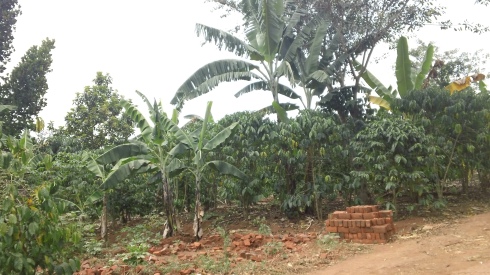
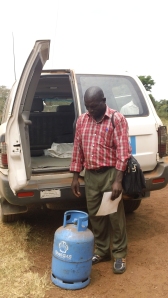
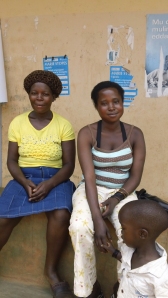
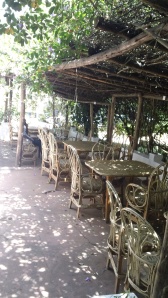
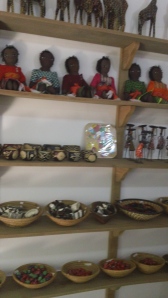
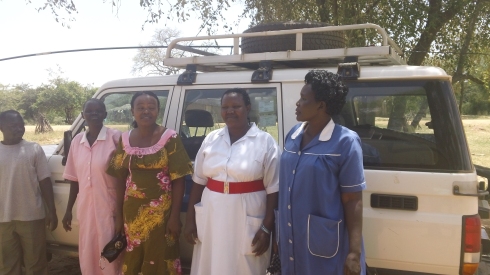
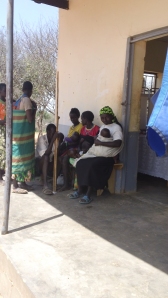
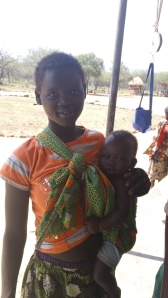

Recent Comments